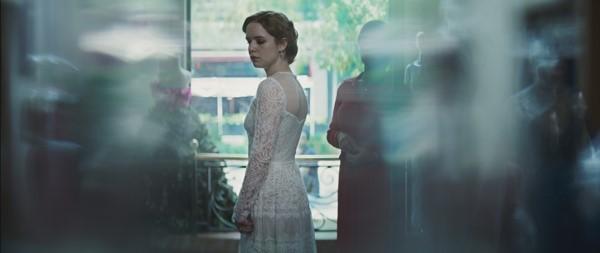A painting fills the screen. Slashes cut across the oil – they might be the trails of missiles, or the skyscrapers of a city under attack, or stilettos. This is Solo los muertes han visto el final de la guerra: ‘only the dead have seen the end of the war’. As the camera pans back we realise the painting is hung on one of the long walls of a house where a wedding party is being celebrated. It’s a perfect shot with which to start New Order (Nuevo Orden), a stylish film about hideous events. The painting takes its title from a quotation that is fully wormed into pop culture – you can read it written on the walls of the Imperial War Museum, see it at the start of Black Hawk Down, buy it on mugs and t-shirts. There’s a coolness and glamour to the phrase that distances it from the horrors it describes.
Comparisons have been made between New Order and Parasite, the award-winning South Korean film from 2019. There are surface similarities: very rich people in lovely (and despite being in Mexico City and Seoul, weirdly similar) houses are under threat from their violent and fed-up economic inferiors. But the comparisons can’t be sustained beyond the opening wedding party. Parasite invited us to sympathise with the Kim family and their rebellion but New Order doesn’t give the audience much chance to sympathise with anyone. It reminded me more of Mother! with its blissful lives unravelling unto apocalypse.
That’s not to say that New Order is not compelling watching. The first 25 minutes are as tensing as I’ve seen in a long time. It draws on horror and dystopic tropes skilfully, and the breakdown is terrifying and surprising. Scenes end halfway through a piece of action and then are returned to with a kind of shrug, with the protagonists now reduced to a footnote. It seems a deliberate choice to make the characters so anonymous. We get enough illustrative details to position the characters in their social strata, but little uniqueness. The moments when personality comes through are rare enough to be memorable: Marianne, the bride of the doomed wedding party, doing a tiny double-take as she enters the living room of one of her family’s employees, and we see the realisation flit across her mind that this is where he lives – not really poor, but not wealthy enough to have taste. Otherwise many of the characters become ciphers: the handsome gilded youths; the naïve young woman; the monstrous soldier.
This anonymity adds to the horror and elegance of the remaining hour. Very little is explained; deaths happen without fanfare; things spiral worse and worse. Predicting who will survive is difficult. There’s not much visual gore but the soundtrack doesn’t spare us, with off-camera screams and mutilations. But this is another area where it differs considerably to Parasite. We engage emotionally with the Kim family because of the dark humour and because of the disdain spat on them by the wealthy Parks. Once the violence in New Order begins it is unremitting and it is only loosely complicated by its links to the background protests, whose causes and goals remain unexplained. The idea is that by reducing the amount of local detail these protests could reflect any of those happening around the world but the effect was similar to the opening painting: a broad canvas of violence and energy, wherein we struggle to find an individual and recognisable face.






